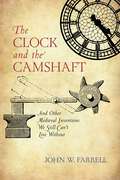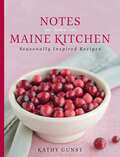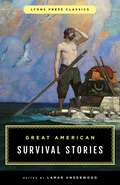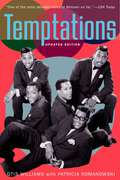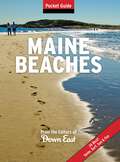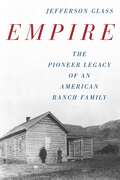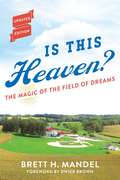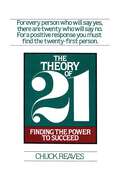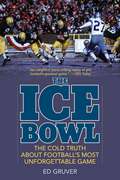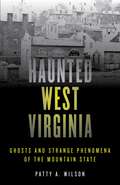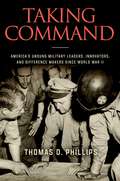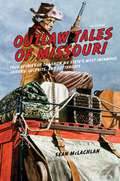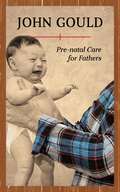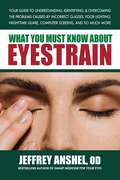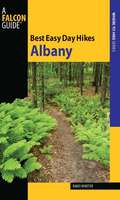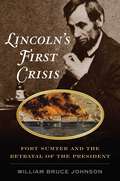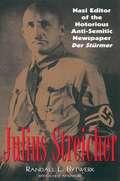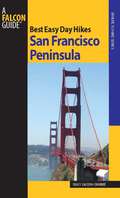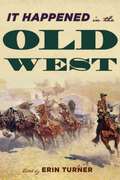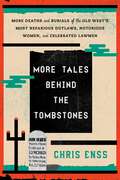- Table View
- List View
Clock and the Camshaft: And Other Medieval Inventions We Still Can't Live Without
by John W. FarrellHighlights the importance of medieval innovations as the basis for later technological progressThis history of medieval inventions, focusing on the eleventh to the fourteenth centuries, vividly portrays a thriving era of human ingenuity—and the results are still being felt to this day. From the mechanical clock to the first eyeglasses, both of which revolutionized society, many of the commonplace devices we now take for granted had their origin in the Middle Ages. Divided into ten thematic chapters, the accessible text allows the reader to sample areas of interest or read the book from beginning to end for a complete historical overview.A chapter on the paper revolution shows that innovations in mill power enabled the mass production of cheap paper, which was instrumental in the later success of the printing press as a means of disseminating affordable books to more people. Another chapter examines the importance of Islamic civilization in preserving ancient Greek texts and the role of translation teams in Sicily and Spain in making those texts available in Latin for a European readership. A chapter on instruments of discovery describes the impact of the astrolabe, which was imported from Islamic lands, and the compass, originally invented in China; these tools plus innovations in ship building spurred on the expansion of European trade and the later age of discovery at the time of Columbus.Complete with original drawings to illustrate how these early inventions worked, this guided tour through a distant era reveals how medieval farmers, craftsmen, women artisans, and clerical scholars laid the foundations of the modern world.
Notes from a Maine Kitchen: Seasonally Inspired Recipes
by Kathy GunstThere's nothing better than settling into a nice, warm, home-cooked meal at the kitchen table. Kathy Gunst takes us into her own kitchen, introducing us to the flavors of fresh, seasonal Maine ingredients prepared in simple and inspiring ways. With essays conveying the mood of each month, Gunst gives readers a sense of Maine food and life. She follows each essay with a handful of recipes incorporating the seasonal ingredient or theme.
Great American Survival Stories: Lyons Press Classics (Classic)
by Lamar UnderwoodFifteen gripping tales of determination, strength of mind, perseverance, and fortitude.Although survival is often taken for granted - something every human strives to achieve on a daily basis - it is just this everyday imperative that makes for the most exciting stories. When something goes wrong, when survival is threatened, often by something as simple and sudden as a boat overturning or a traveler losing his way, this is when the necessity of survival is no longer just another daily chore. This is when something as intrinsic as breathing or swallowing becomes the most essential need and the most sought-after desire.
Temptations: Revised and Update
by Otis WilliamsThe Temptations were the most commercially successful and critically lauded male vocal group of the Sixties and early Seventies. Through the years, the group's trademark razor-sharp choreography, finely tuned harmonies, and compelling vocals made them the exemplars of the Motown style. This is the frank, revealing story of the legendary supergroup, told by its founder.
Our Favorite Food Gifts
by Gooseberry PatchBrimming with ideas to inspire you year 'round, Our Favorite Food Gifts cookbook is just what you've been looking for. We've gathered a collection of mixes and recipes for every season!Whatever the occasion, we've got just the gift you'll want to give. For birthdays, Mothers&’ Day or anytime, all of these gifts are sure to wow &’em! Best of all, you'll find lots of fresh and clever ways to package gifts from your kitchen and new ways to celebrate every day with family & friends.
Maine Beaches: Pocket Guide
by Publishers of Down EastMaine has dozens of wonderful beaches tucked away in the nooks and crannies of the coast. This handy guide makes 18 of the state's favorite beaches easy to find and includes loads of useful information so you can make the most of your time at the shore.
Big Food, Big Pharma, Big Lies: Exposing the Dangers Within the Pharmaceutical and Agriculture Industries
by Martha RosenbergThis hard-hitting exposé by leading national muckraker Martha Rosenberg blows the lid off of everything you thought you knew about Big Pharma and Big Food. What goes on behind the scenes in these industries is more suspicious, more devious, more disreputable than you could have ever imagined.Rosenberg&’s message is clear: the pharmaceutical and agricultural industries are tainting public health through marketing disguised as medical education and research, aggressive lobbying, and high-level conflicts of interest.If you&’re concerned about the safety of the drugs you take and the food you eat, you owe it to yourself to read this important book.Having gained the trust of more than twenty doctors, researchers, and experts who were willing to come forward and finally tell all, reporter and editorial cartoonist Martha Rosenberg presents us with her shocking findings. Explosive material from whistle-blowers, scientists, unsealed lawsuits, and Big Pharma&’s and Big Food&’s own marketers exposes how these industries put profits before public safety and how the government puts the interests of business before the welfare of consumers, creating a double whammy that &“pimps&” the public health. What Rosenberg reveals about government complicity, regulatory food- and drug-safety lapses, and legislative injustices will both shock and appall.Why have federal meat inspectors become pathetic figureheads in the nation&’s slaughterhouses, laughed at by plant managers? Why are medical articles that have been exposed in lawsuits as fraudulent still standing and not retracted? Why was meat possibly containing the United States&’ first mad cow sold to five California restaurants when the government said it wasn&’t? And why are parents giving their one-year-olds acid reflux medications and their three-year-olds bipolar disorder medications? You&’ll find the answers to these and many more disturbing questions in this revealing book.
Empire: The Pioneer Legacy of an American Ranch Family
by Jefferson GlassA collage of characters shaped the west of the nineteenth century. Large and powerful cattlemen, backed by eastern and European investors, flooded the prairie with herds often numbering 50-80 thousand head. They had visions of doubling or tripling their money quickly while their cattle grazed on the free grass of the open range. Others, like Martin Gothberg wisely invested in the future of the young frontier. Starting with a humble 160-acre homestead in 1885, he continued to expand and develop a modest ranch that eventually included tens of thousands of acres of deeded land. Gothberg&’s story parallels the history of open range cattle ranches, cowboys, roundups, homesteaders, rustlers, sheep men and range wars. It does not end there. As the Second Industrial Revolution escalated in the late 1800s, so did the demand for petroleum products. What began with a demand for beef to feed the hungry cities of the eastern United States fostered the demand for wool to clothe them and graduated into a demand for oil to warm them in winter and fuel the mechanized age of the twentieth century. All were a critical part of shaping American history. Through the lens of this family saga—a part of the history of the West comes to life in the hands of this storyteller and historian.
Is This Heaven?: The Magic of the Field of Dreams
by Brett MandelMore than three decades ago, the film Field of Dreams made grown men cry with its tale of a son's quest to know his father through the magic of baseball. The mystical baseball field of that movie continues to attract thousands of visitors and here is the story of a make-believe place made real, its incredible lure, and its effect on the people who have stepped between its chalk lines.
The Theory of Twenty One
by Chuck ReavesAccording to the theory of 21, there are twenty people who will say no for every person who says yes. The secret to success in business is finding the 21st person, the individual who is open to ideas and innovation and who makes abstract ideas become reality.This book helps you identify the twenties--those who dislike change and fear risk--and teaches you how to elude them and to persevere despite their repeated assurances that whatever you're trying to do won't work.
The Ice Bowl: The Cold Truth About Football's Most Unforgettable Game
by Ed GruverThe day of the Ice Bowl game was so cold, the referees' whistles wouldn't work; so cold, the reporters' coffee froze in the press booth; so cold, fans built small fires in the concrete and metal stands; so cold, TV cables froze and photographers didn't dare touch the metal of their equipment; so cold, the game was as much about survival as it was about skill and strategy. On New Year's Eve, 1967, the Dallas Cowboys and the Green Bay Packers met for a classic NFL championship game, played on a frozen field in sub-zero weather. The "Ice Bowl" challenged every skill of these two great teams. Here's the whole story, based on dozens of interviews with people who were there—on the field and off—told by author Ed Gruver with passion, suspense, wit, and accuracy.
Power, Politics, and Universal Health Care: The Inside Story of a Century-Long Battle
by Stuart AltmanEssential reading for every American who must navigate the US health care system. Why was the Obama health plan so controversial and difficult to understand? In this readable, entertaining, and substantive book, Stuart Altman-internationally recognized expert in health policy and adviser to five US presidents-and fellow health care specialist David Shactman explain not only the Obama health plan but also many of the intriguing stories in the hundred-year saga leading up to the landmark 2010 legislation. Blending political intrigue, policy substance, and good old-fashioned storytelling, this is the first book to place the Obama health plan within a historical perspective. The authors describe the sometimes haphazard, piece-by-piece construction of the nation's health care system, from the early efforts of Franklin Roosevelt and Harry Truman to the later additions of Ronald Reagan and George W. Bush. In each case, they examine the factors that led to success or failure, often by illuminating little-known political maneuvers that brought about immense shifts in policy or thwarted herculean efforts at reform. The authors look at key moments in health care history: the Hill-Burton Act in 1946, in which one determined poverty lawyer secured the rights of the uninsured poor to get hospital care; the "three-layer cake" strategy of powerful House Ways and Means Committee Chairman Wilbur Mills to enact Medicare and Medicaid under Lyndon Johnson in 1965; the odd story of how Medicare catastrophic insurance was passed by Ronald Reagan in 1988 and then repealed because of public anger in 1989; and the fact that the largest and most expensive expansion of Medicare was enacted by George W. Bush in 2003. President Barack Obama is the protagonist in the climactic chapter, learning from the successes and failures chronicled throughout the narrative. The authors relate how, in the midst of a worldwide financial meltdown, Obama overcame seemingly impossible obstacles to accomplish what other presidents had tried and failed to achieve for nearly one hundred years.
Haunted West Virginia: Ghosts and Strange Phenomena of the Mountain State (Haunted Series)
by Patty A. WilsonThrilling stories of supernatural occurences in West Virginia, including the restless spirits of Harpers Ferry, the legendary Mothman of Point Pleasant, the ghosts of Twistabout Ridge, the phantom hitchhikers on the West Virginia Turnpike, and many more.
Taking Command: America's Unsung Military Leaders, Innovators, and Difference Makers Since World War II
by Thomas D. PhillipsBeyond the pantheon of Patton, Eisenhower, MacArthur, and Nimitz lies an untold story of military genius — the innovative commanders who stepped from their shadows to shape modern warfare from the Cold War to the War on Terror. From the general who made the impossible Berlin Airlift succeed to the mastermind behind the raid that killed Osama bin Laden, Taking Command unveils the remarkable stories of twenty-four unsung military leaders who transformed America's fighting forces. These commanders didn't just execute orders— they revolutionized warfare through innovation, unconventional thinking, and sheer determination. Through portraits of these exceptional leaders, readers will discover: How "Tonnage Tunner" moved 1.8 million tons of supplies during the Berlin Airlift The Marine general whose controversial Vietnam tactics cost him his career but proved prescient How Admiral McRaven's leadership principles extend far beyond his famous "make your bed" speech The untold story behind the "Be All You Can Be" commander who later led the Panama invasion Written by retired Air Force veteran Thomas Phillips, this compelling narrative serves both as a vital missing chapter in American military history and a masterclass in leadership under pressure. For anyone fascinated by military strategy or seeking to understand the qualities of exceptional leadership, Taking Command offers unprecedented access to the minds of America's most innovative military commanders.
Outlaw Tales of Missouri: True Stories of the Show Me State's Most Infamous Crooks, Culprits, and Cutthroats (Outlaw Tales)
by Sean MclachlanTrue stories of the Show Me state&’s most infamous crooks, culprits, and cutthroats.
The Probiotic Cure: Harnessing the Power of Good Bacteria for Better Health
by Martie WhittekinIn 1982, it was discovered that the vast majority of stomach ulcers are caused by H. pylori, nasty little bacteria found in the gut. In spite of the evidence, it took the U.S. medical community ten years to accept this finding and change their treatment of ulcers. In 2015, scientists have come to an equally startling conclusion: An imbalance in the bacterial community of your stomach can cause not only ulcers, but also a host of other serious and painful disorders— from allergies to diabetes to osteoporosis. Now, best-selling health author Martie Whittekin has written The Probiotic Cure, a guide to overcoming many of our most common health issues. The Probiotic Cure is divided into two parts. Part One is designed to explain what our internal flora is and how it works in our gut. It examines what comprises this living community, specifically focusing on the natural balance of bad and good bacteria. It details how this community can become unbalanced from a poor diet, a toxic environment, or a number of medications, causing negative consequences for your health. It then goes on to explain how balance can be restored safely and effectively by using probiotics—good bacteria that are readily available in supplement form. Part Two provides a listing of the most common health disorders that may arise from a bacterial imbalance. Each entry includes a look at conventional treatments for the disorder along with the probiotics approach. Practical suggestions and points to consider are offered so that you can make the best decision possible for your well-being. Hopefully, it will not take another ten years for the medical community to recognize the power of probiotics. But with this book in hand, you can benefit today from groundbreaking research. The Probiotic Cureprovides a safe, natural, and wonderfully effective alternative approach to treating many of the major health problems of our time.
Pre-Natal Care for Fathers
by John GouldMaine curmudgeon John Gould offers humorous tongue-in-cheek advice for fathers-to-be with a non-medical, non-technical, non-scientific explanation of the masculine side of the matter, with much that is useful and nothing that is wholly useless.
What You Must Know About Eyestrain
by Jeffrey AnshelDo you often find yourself rubbing your eyes? After working on a display screen or reading a book, do you wind up having a headache? Do you seem to have problems focusing your vision, with or without glasses? If the answer to any of these questions is yes, you may be suffering from eyestrain. Your vision is one of your most important senses, and by not recognizing the signs of eyestrain, you leave yourself subject to a host of problems, including:- Headaches- Blurred vision- Eye pain- Dry eye- Excessive tearing- Excessive blinking- Double vision- Eye fatigue- Heavy eyes- Burning sensation- Difficulty focusing- Poor night vision- Neck & shoulder pain- Poor visual acuity- Bloodshot eyesThe good news is that there is no reason to suffer from these common and annoying symptoms. Noted optometrist and bestselling author Jeffrey Anshel, OD, has written a guide to understanding and eliminating all of them. Written in plain English, What You Must Know About Eyestrain provides you with the up-to-date information required to identify the source of the problem—whether it is your display screen, inadequate lighting, poor nutrition, or merely the process of aging—and take the necessary steps to resolve it.If you are one of the millions of people suffering from eyestrain, you will discover that, with few exceptions, most of the solutions to this problem are both simple and relatively inexpensive to achieve. With a copy of What You Must Know About Eyestrain in hand, you will be able to see your way to comfortable vision.
Best Easy Day Hikes Albany (Best Easy Day Hikes Series)
by Randi MinetorBest Easy Day Hikes Albany includes concise descriptions of the best short hikes in the area, with detailed maps of the routes. The 18 hikes in this guide are generally short, easy to follow, and guaranteed to please.
Lipsmackin' Vegetarian Backpackin': Lightweight, Trail-Tested Vegetarian Recipes for Backcountry Trips
by Christine Conners Tim ConnersTired of power bars, half-cooked quick rice, and endless trail recipes featuring dehydrated chicken by-products? Try meat-free dishes like Flyin' Brian's Triple Crown Curry Couscous, Springer Mountain Pesto, and Time-Traveler's Tamales instead. The sequel to the top-selling Lipsmackin' Backpackin', this all-in-one backpacker's food guide has more than 150 trail-tested, meatless recipes that provide at-home preparation directions, trailside cooking instructions, detailed nutritional information, serving suggestions, the weight of the ingredients, and meal-planning tips from some of the most experienced long-distance hikers in the world. The recipes are organized in six sections: breakfast, lunch, dinner, breads, snacks and desserts, and drinks. There is a separate chapter on food preparation and cooking tips, contact information for sources of ingredients, measurement conversions, and a special section of Packable Trailside Cooking Instructions--short directions for each recipe so readers don't have to pack the whole book. This is the most complete guide ever written to meatless eating on the trail, an indispensable resource for vegetarian backpackers, and a great source for recipes for anyone who wants great-tasting and nutritious meals trailside.
Lincoln's First Crisis: Fort Sumter and the Betrayal of the President
by William Bruce JohnsonLincoln&’s First Crisis concerns five of the most consequential months in American history: December 1860 through April 1861. When Abraham Lincoln swore his oath as president, the United States was disintegrating. Seven states had seceded, and as many as eight seemed poised to join them, depending upon how the new president handled the secession crisis and its flashpoint: Fort Sumter in South Carolina, the heart of the rebellion. The fate of the republic hung in the balance. The Sumter crisis has been hotly debated and deeply researched for more than 150 years. In this thoughtful reassessment, William Bruce Johnson combines thorough research and the latest historiography with a litigator&’s methodical analysis and a storyteller&’s eye for meaningful detail. Shortly after taking office, Lincoln decided upon a plan to avoid war with the seceded states while keeping his inaugural promise to maintain a Union military presence in the South. Because he chose not to reveal his plan to anyone, rumors soon spread that he was simply afraid to act. One source of such rumors was Lincoln&’s secretary of state, William Henry Seward. Resentful that Lincoln had deprived him of the Republican nomination and convinced that Lincoln lacked the political sophistication necessary to deal with the secession crisis, Seward decided to negotiate with the Confederacy on his own and in secret. General Winfield Scott, meanwhile, the Union&’s most senior military officer, had for a decade depended upon Seward for political advice, and now considered himself under orders from Seward, not the president. Johnson traces how Seward and Scott sabotaged Lincoln&’s plan. From this account, from his examination of various personalities (such as that of Fort Sumter&’s commander, Major Robert Anderson), and from his granular research into aspects of the Order of Battle in Charleston, Johnson has here constructed a new narrative of this crucial period, culminating in a new theory of how and why the Civil War began as it did, and how and why, if the new president&’s orders had been properly carried out by Seward and Scott, it might have been averted.
Julius Streicher: Nazi Editor of the Notorious Anti-semitic Newspaper Der Sturmer
by Randall BytwerkThe Nazis put a remarkable amount of effort into anti-Semitic propaganda, intending to bring ordinary Germans around to the destructive ideology of the Nazi party. Julius Streicher (1885-1946) spearheaded many of these efforts, publishing anti-Semitic articles and cartoons in his weekly newspaper, Der Stürmer, the most widely read paper in the Third Reich. Streicher won the close personal friendship of Hitler and Himmler, and drew deserved attacks from the world press. Bytwerk's biography examines Streicher's use of propaganda techniques, and the hate literature towards Jews that continued to appear after his death, bearing his influence.
Best Easy Day Hikes San Francisco Peninsula (Best Easy Day Hikes Series)
by Tracy SalcedoBest Easy Day Hikes San Francisco Peninsula features concise descriptions and easy-to-follow maps of nineteen easily manageable hikes.
It Happened in the Old West: Remarkable Events that Shaped History (It Happened in the West)
by Erin H. TurnerThese are the stories of what happened in the West as the trickle then flood of Easterners and immigrants first began to flow into the plains, deserts, and mountains between the Pacific Ocean and the Mississippi River and, finally, far north into The Last Frontier. While some events would have happened regardless who was there—earthquakes, storms, droughts, and other natural disasters—it was because of this influx of humanity that those events were recorded and have become part of America&’s history.Amid tales of loss and horror are accounts of survival and success. And among the countless adventurers who found the lure of wide open spaces and untapped resources to be as strong as the Sirens&’ song to Odysseus, many found the determination to thrive in the West. And thrive they did—even better, for what they lacked in resources they made up in resourcefulness, becoming inventors, entrepreneurs, scientists, activists, explorers and more.
More Tales behind the Tombstones: More Deaths and Burials of the Old West's Most Nefarious Outlaws, Notorious Women, and Celebrated Lawmen
by Chris EnssMore Tales Behind the Tombstones tells the stories behind the deaths (or supposed deaths) and burials of even more of the Old West's most nefarious outlaws, notorious women, and celebrated lawmen. Readers will learn the stories behind these legendary characters and visit the sites of tombs long forgotten while legends have lived on.Read about the lives (and deaths) of fearless, famous lawmen such as Bass Reeves, Chalk Beeson, Bill Tilghman, and Pat Garrett; learn about the dauntless women who blazed new paths for their sex in medicine, journalism, entertainment, and voting rights; and discover the intriguing facts and myths that continue to circulate about these and other infamous characters long after their grave markers have become worn down or simply lost to time.
